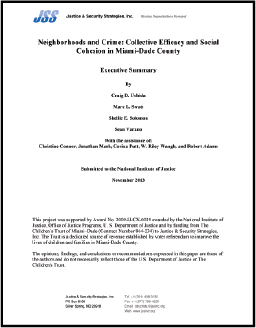
This paper describes a study of collective efficacy in Miami-Dade, Florida. The study investigates the following research questions:
What are the psychometric properties of the most popular measure of perceptions of collective efficacy (the Sampson, Raudenbush, and Earls (1997) scale)? Is this measure appropriate and well constructed and is it being modeled correctly in extant research on collective efficacy?
At the level of individual perceptions, what are the important relationships between perceptions of collective efficacy and related constructs and other important perceptual outcomes, such as perceptions of incivilities, satisfaction with the police, and fear of crime?
Do the relationships between perceptions of collective efficacy and related constructs and other key variables vary between neighborhoods? In other words, is there heterogeneity in the impact of perceptions of collective efficacy in different social contexts? If so, how does the impact of perceptions of collective efficacy vary and what are potential explanations for this heterogeneity?
What variables predict perceptions of collective efficacy and related constructs? Do a person’s activities within the neighborhood influence the degree to which they perceive it to function properly?
Is there local variability in collective efficacy and other related constructs within neighborhoods? What strategies are available for modeling this variability?
